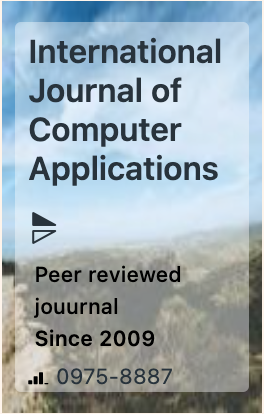The week's pick
Random Articles
Reseach Article
Impact of Artificial Intelligence Among the Employees Working in IT/ITES Sector
| International Journal of Computer Applications |
| Foundation of Computer Science (FCS), NY, USA |
| Volume 186 - Number 62 |
| Year of Publication: 2025 |
| Authors: P. Mohanraj, M. Vijayakumar, V.C. Srinivasan |
 10.5120/ijca2025924432
10.5120/ijca2025924432
|
P. Mohanraj, M. Vijayakumar, V.C. Srinivasan . Impact of Artificial Intelligence Among the Employees Working in IT/ITES Sector. International Journal of Computer Applications. 186, 62 ( Jan 2025), 68-73. DOI=10.5120/ijca2025924432
Abstract
Artificial intelligence (AI) technologies offer huge potential for social and economic transformation within the broader framework of digital change. They can completely transform businesses, industries, labor markets, and even society. Despite the challenges facing their deployment, generative AI systems can create value for customers, simplify processes, increase human knowledge through insights and solutions, and help businesses achieve or retain a competitive advantage. The study aimed at knowing theimpact of artificial intelligence among the employees working in IT/ITES sector located in Coimbatore District. The questionnaire was designed to collect 100 data from the employees working in IT/ITES industry of Coimbatore District. Convenience sampling method was used to collect the data. The study found that all the relationships between AI and the outcomes (for example, skill development, job quality, and societal implications) are statistically significant, with p-values of *** indicating strong evidence against the null hypothesis. The coefficients indicate the strength of these relationships, with the impact on employment disruption (1.798) and ethical issues and bias (1.728) being particularly strong. This data illustrates that AI has the potential to boost various dimensions of the workplace-from skill development to job quality-but also poses heavy challenges in terms of unemployment disruption, increased skill-related disparities, and ethical issues. With the increasing demand from employees for more strategic commitment and responsiveness, employers need to get the appropriate tools and input for decisions that will continue pushing business development and facilitate employment opportunities. The study concluded that technological innovation in the IT/ITES sector calls for employees' adaptation and embracing AI-driven change for better competitiveness at work. In a nutshell, AI can very much improve employee productivity and capacity in the IT/ITES sector but requires apt training, skill building, and strategic preparation for handling the challenges introduced by it.
References
- Dwivedi, P. (2024). Future of AI and how it will impact the workforce and employee training. Auzmor.https://auzmor.com/blog/how-ai-impact-the-workforce-and-employee-training/
- Zirar, A., Ali, S.I., & Islam, N. (2023). Worker and workplace artificial intelligence (AI) coexistence: Emerging themes and research agenda. Technovation, 124.doi.org/10.1016/j.technovation.2023.102747
- Necula, S. -C., Fotache, D., & Rieder, E. (2024). Assessing the impact of artificial intelligence tools on employee productivity: Insights from a comprehensive survey analysis. Electronics, 13(18), 3758. doi.org/10.3390/electronics13183758
- Chatterjee, S. (2021). A new coefficient of correlation. Journal of the American Statistical Association, 116(536), 2009-2022.
- Agrawal, A., Gans, J. S., & Goldfarb, A. (2019). Artificial intelligence: the ambiguous labor market impact of automating prediction. Journal of Economic Perspectives, 33(2), 31-50
- Agarwal, K., Kumar, M., Lahoti, M., Nairita, & Megha. (2024). A study on impact of artificial intelligence on employment trends.International Journal of Novel Research and Development, 9(3), g691-g708.
- Nayal, K., Raut, R., Priyadarshinee, P., Narkhede, B. E., Kazancoglu Y., &Narwane, V. (2021). Exploring the role of artificial intelligence in managing agricultural supply chain risk to counter the impacts of the COVID-19 pandemic. The International Journal of Logistics Management. doi: 10.1108/IJLM-12-2020-0493.
- Budhwar, P., Malik, A., De Silva, M. T., &Thevisuthan, P. (2022). Artificial intelligence–challenges and opportunities for international HRM: a review and research agenda. The International Journal of human resource management, 33(6), 1065-1097.
- Babashahi, L., Barbosa, C. E., Lima, Y., Lyra, A., Salazar, H., Argôlo, M., Almeida, M. A. d., & Souza, J. M. d. (2024). AI in the Workplace: A Systematic Review of Skill Transformation in the Industry. Administrative Sciences, 14(6), 127. https://doi.org/10.3390/admsci14060127
- Usman, M., Khan, R., & Moinuddin, M. (2024). Assessing the Impact of Artificial Intelligence Adoption on Organizational Performance in the Manufacturing Sector. Revista Espanola de Documentacion Scientific, 18(02), 95-116.
- Ambati, L.S., Narukonda, K., Bojja, G.R., & Bishop, D. (2020). Factors Influencing the Adoption of Artificial Intelligence in Organizations – From an Employee’s Perspective. MWAIS 2020 Proceedings, 20. https://aisel.aisnet.org/mwais2020/20
- Jaiswal, A., Arun, C. J., & Varma, A. (2021). Rebooting employees: upskilling for artificial intelligence in multinational corporations. The International Journal of Human Resource Management, 33(6), 1179–1208. https://doi.org/10.1080/09585192.2021.1891114
- Budhwar, P., Malik, A., De Silva, M. T. T., &Thevisuthan, P. (2022). Artificial intelligence – challenges and opportunities for international HRM: a review and research agenda. The International Journal of Human Resource Management, 33(6), 1065–1097. https://doi.org/10.1080/09585192.2022.2035161
- Petropoulos, G. (2018). The impact of artificial intelligence on employment.Work in the Digital Age, 119-132.
- Tiwari, S.K., Tiwari, P., & Anand, N. (2023). Impact of artificial intelligence to automate management of employee benefits. Pacific Business Review (International), 16 (2), 25-33.
Index Terms
Keywords

